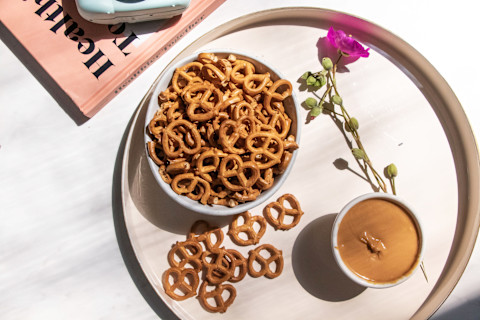What You Really Need To Know About Going Grain-Free, An Integrative Nutritionist Explains

Grain-free, wheat-free, gluten-free: There's a lot of chatter going around in the nutrition world surrounding these diets. But what's the big deal?
The movement away from grains has become increasingly popular over the years, which is something I'm seeing firsthand as an integrative nutritionist. People are reporting losing weight and having higher energy levels, clearer skin, and resolved digestive issues when they limit or go completely grain-free.
Going against the grain: A brief history.
The most common grains are wheat, oats, corn, and rice. From a nutritional standpoint, these foods are an excellent source of fiber that our bodies need. But while it's true that we've been subsisting on grains for thousands of years, the problem is that the grains we eat today look nothing like the grains our ancestors ate.
Before we started milling grains, they were stone ground in their whole form. That means the flour still contained all of the grain (bran, germ, and endosperm) and all its nutrients along with it (vitamins, minerals, and fiber). But thanks to the modern development of the mill, we started removing everything except the endosperm to create a very cheap, finely ground white flour, making white bread as a result.
It was the 1940s, and this new bread was cheaper, more accessible, and had a longer shelf life. But when people started developing vitamin deficiencies from the lack of nutrients in this bread, the solution was to enrich it with synthetic vitamins and minerals. Say what you will here, but nothing made in a lab will ever hold a candle to the true nourishing properties of real vitamins and minerals in their whole state.
Then in the 1960s, agronomists sought to increase the amount of wheat they could grow per acre. A new type of wheat called dwarf wheat was developed, which is the modern form of the wheat that we eat today.

Our modern wheat woes.
This wheat has been specifically engineered to produce more crop on less acreage—another product of the mass industrialization of our food. This wheat yields more product; however, it's significantly lower in zinc, magnesium, copper, and iron than the ancient varieties of wheat our ancestors used to eat (spelt, einkorn, and emmer).
In addition to our modern wheat containing fewer nutrients, we just process it very differently than nutritional science tells us we should. So in order to maximize the nutrients in grains, a practice from almost all cultures is to soak, sprout, and/or ferment (sourdough) the grains. This process makes the nutrients more bioavailable to the body.
Another concern is pesticide use, particularly glyphosate, here in the U.S.: Wheat is among the most sprayed crops here in this country, while other countries don't allow these pesticides. (There is a theory that it's not the grain so much as it is the toxic load from the pesticides sprayed on our grains that's the issue.)
This might explain why we are seeing such an increase in gluten and wheat allergies and why other countries don't seem to have the same issues we do with grains. Truth be told, I hear countless stories from clients who can freely eat bread and gluten products when they go overseas with no intestinal distress.
A nutritionist's stance on grains.

The conventional grains of the standard American diet (SAD) are highly inflammatory and should be avoided. Instead, opt for organic, sprouted, and ancient varietal (spelt, emmer, and einkorn) when you can! There are so many grain-free alternatives these days, including grain-free granola, chips, tortillas, and my new favorite snack—the first-ever grain-free pretzels that I've seen, FitJoy's Grain Free pretzels that are totally gluten-free, dairy-free, and plant-based.
Personally, I limit my grain intake and have been swapping in gluten-free grains for the past eight years when I can. While I don't completely avoid them, I make sure that the grains I do eat are high-quality and organic, and I consume them in smaller quantities.
I opt for white rice, buckwheat, and gluten-free sourdough, and I bake mostly with grain-free flours such as almond, coconut, and cassava flour. I love to swap out grains for vegetable alternatives such as zucchini or sweet potato noodles in place of pasta, cauliflower rice instead of rice, and I'll shop for cassava flour tortillas and grain-free granola, crackers, and pretzels—a welcome addition to my snacking rotation. The ones from FitJoy are made with cassava flour, chickpea flour, just a touch of honey, and Himalayan pink salt. Did I mention they taste divine dipped in peanut butter? You heard it here first!
